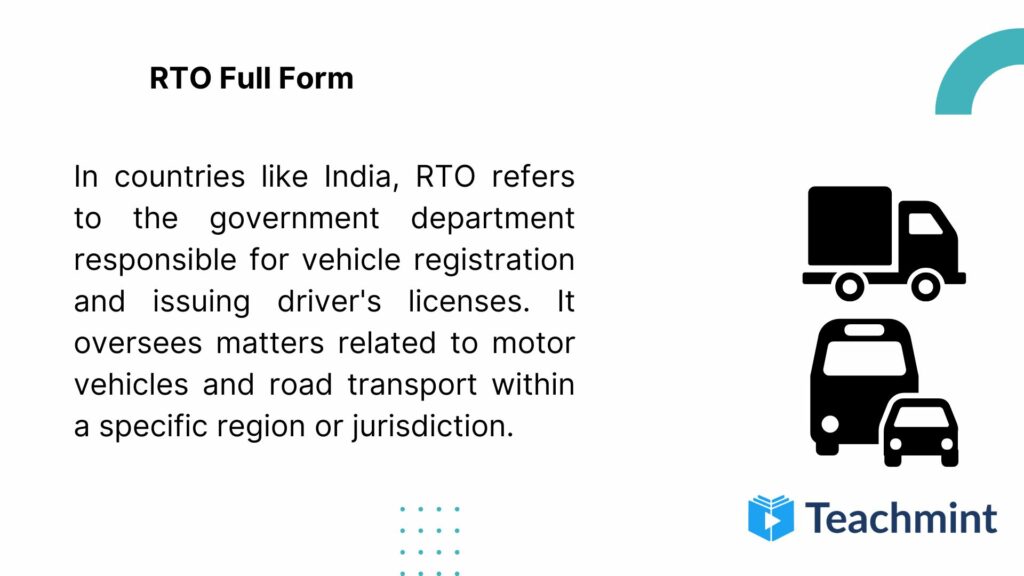The acronym “RTO” often evokes mixed emotions in India, ranging from relief during license renewal to trepidation when facing traffic violations. But what exactly does RTO Full form stand for, and what role does it play in regulating our roads and vehicles? In this article, we delve deeper into the RTO Full Form – Regional Transport Office – its responsibilities, functions, and significance in ensuring smooth and safe transportation within India.
The Guardian of the Roads:
Established under the Motor Vehicles Act, 1988, RTOs function as regional-level authorities, with one office in each state and union territory. These offices operate under the Transport Department of the respective state government, headed by a Transport Commissioner and staffed by trained personnel.
Core Responsibilities:
The RTO’s primary functions revolve around regulating and managing motor vehicles and drivers within its jurisdiction. These responsibilities encompass a wide range of activities, including:
- Vehicle Registration: Every vehicle plying on Indian roads requires registration with the RTO. This process involves issuing registration plates, certificates, and collecting taxes, ensuring all vehicles are accounted for and their ownership is documented.
- Driver Licensing: RTOs conduct driving tests, issue driver’s licenses based on test results and driving aptitude, and maintain a driver database with relevant information and traffic violation records.
- Permit Issuance: Commercial vehicles like taxis, buses, and goods carriers require special permits issued by the RTO. This ensures adherence to specific regulations and safety standards for commercial operations.
- Traffic Enforcement: RTOs play a crucial role in enforcing traffic rules and regulations. They issue challans (fines) for violations, conduct vehicle inspections, and can even suspend or revoke licenses for serious offenses.
- Revenue Collection: Through vehicle registration, taxes, and fines, RTOs contribute significantly to government revenue, which is then used for road infrastructure development, public transportation, and road safety initiatives.

Benefits and Impact:
An efficient and well-functioning RTO system offers several benefits:
- Enhanced Road Safety: By issuing licenses only to qualified drivers and enforcing traffic rules, RTOs contribute to reducing accidents and ensuring safer roads for everyone.
- Organized Vehicle Management: Registration and issuance of permits help regulate the number and type of vehicles on the road, managing traffic flow and preventing congestion.
- Transparency and Accountability: Transparent procedures and online services promote accountability and prevent corruption within the system.
- Revenue Generation: The revenue generated by RTOs is crucial for infrastructure development, improving public transportation, and funding road safety initiatives.
Challenges and the Road Ahead:
Despite its vital role, the RTO system faces certain challenges:
- Long queues and delays: Processing applications and services can be slow and cumbersome, leading to frustration for citizens.
- Corruption and inefficiency: While efforts are being made to address it, some pockets of corruption and inefficiency persist.
- Lack of awareness: Many citizens are unaware of RTO procedures and rules, leading to delays and complications.
Improving the System:
Several initiatives are underway to modernize and improve the RTO system, including:
- Digitization: Online services for applications, renewals, and payments are being implemented for convenience and transparency.
- Faceless Services: RTOs are moving towards faceless services to minimize human interaction and reduce opportunities for corruption.
- Public Awareness Campaigns: Educating citizens about RTO procedures and traffic rules is crucial for smoother functioning.
- Stricter Enforcement: Stringent enforcement of traffic rules and regulations is essential to deter violations and improve road safety.
Conclusion:
The RTO plays a vital role in ensuring safe, efficient, and organized road transportation in India. Understanding its functions, responsibilities, and challenges is crucial for citizens to navigate the system effectively and participate in creating a safer and more sustainable transportation environment. With continuous improvements and public cooperation, the RTO can truly fulfill its vision of a well-regulated and safe road ecosystem for all.
Learn more about Teachmint plans here.
